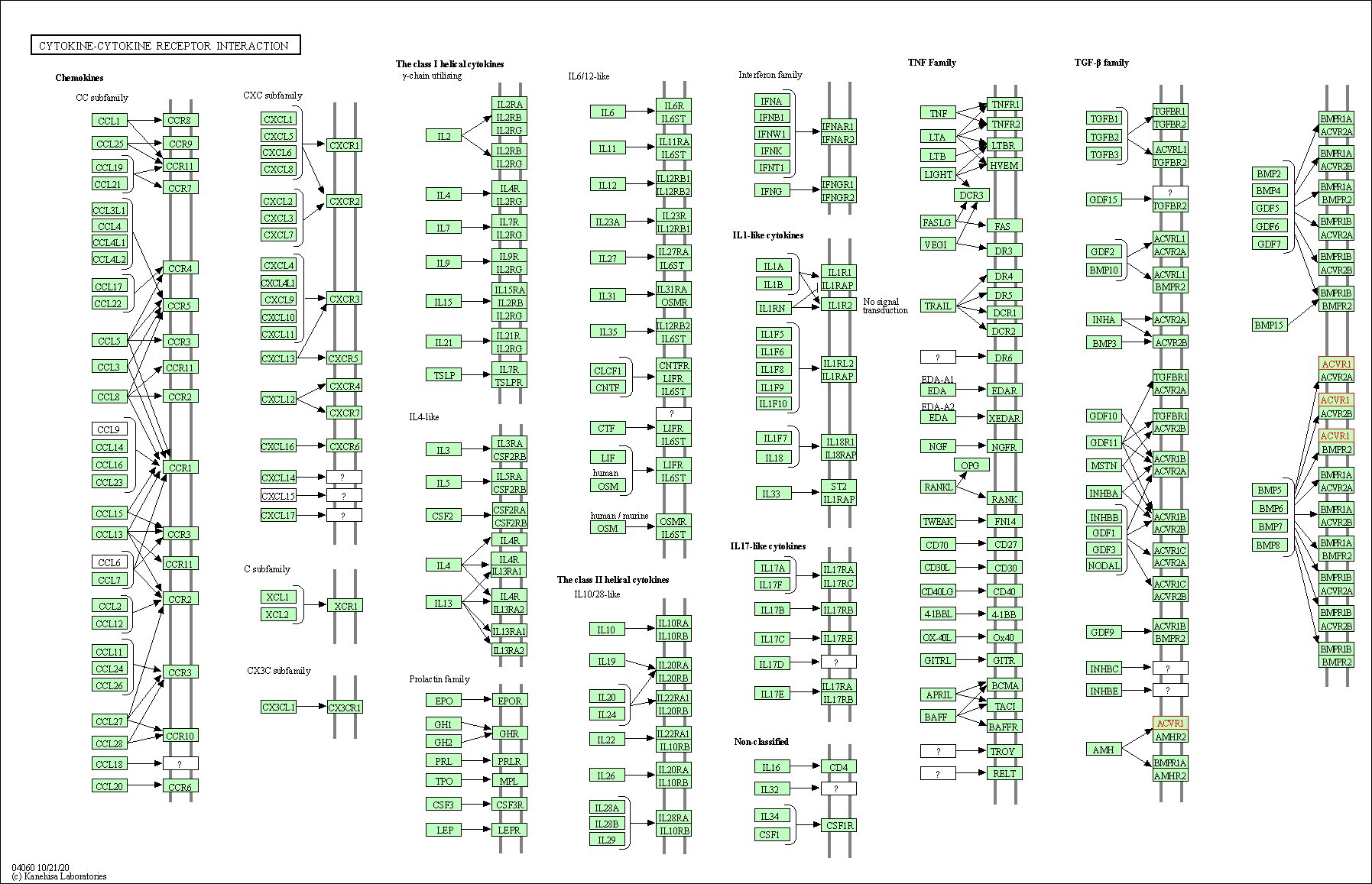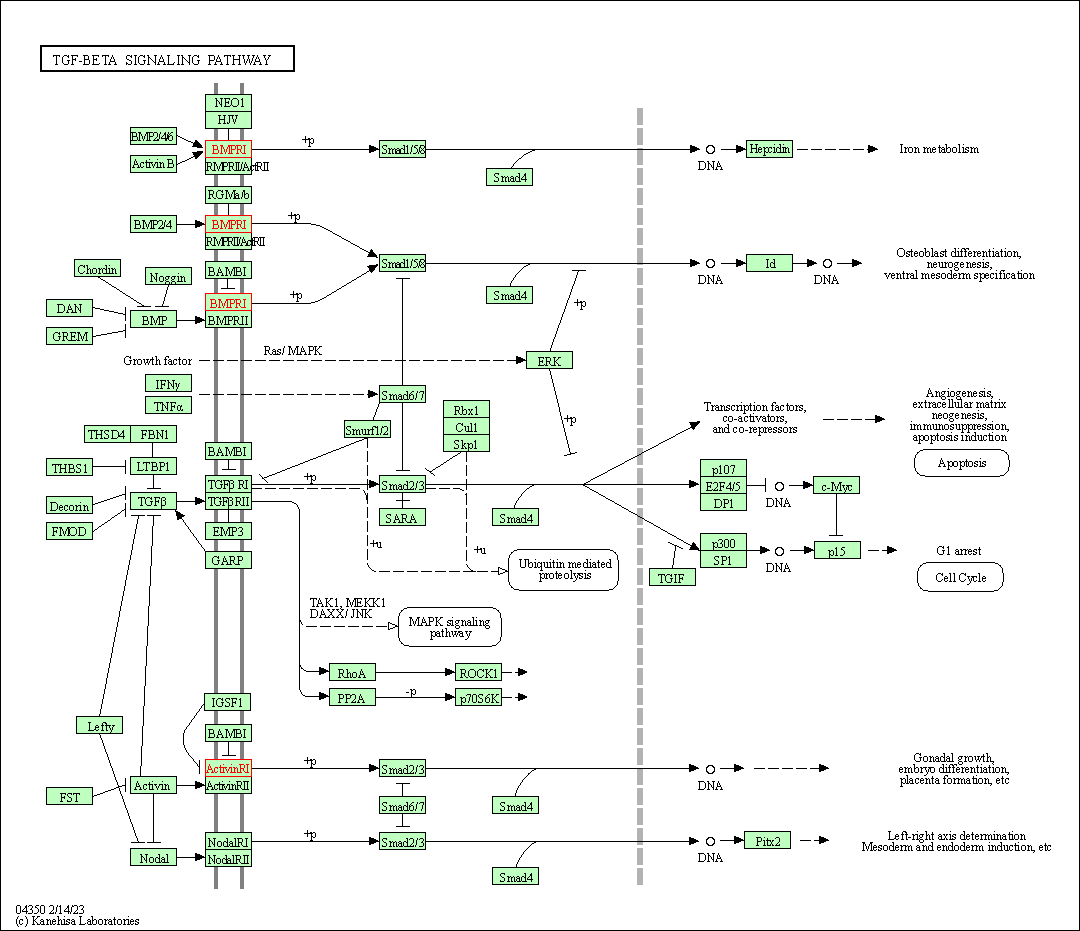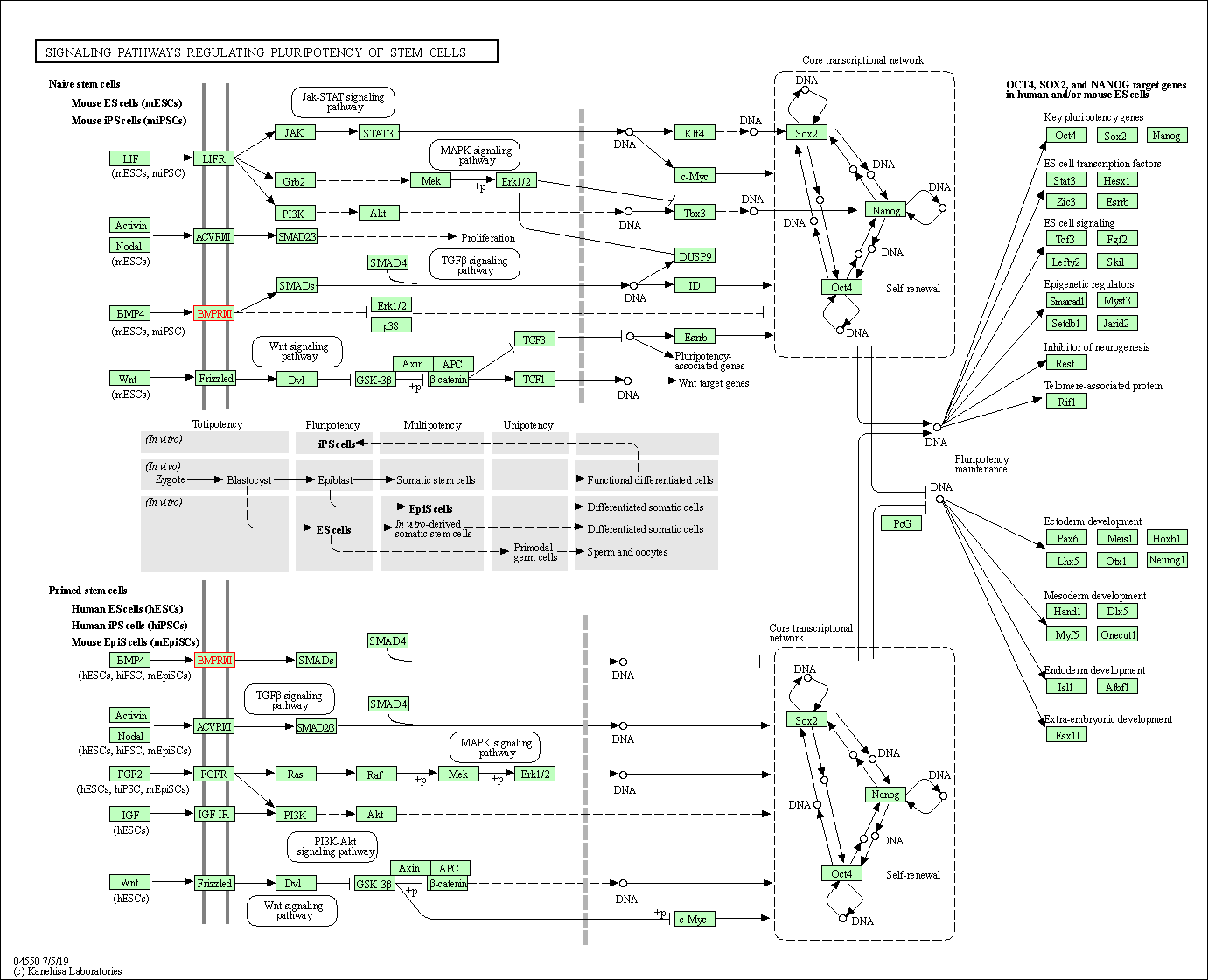Target Information
| Target General Information | Top | |||||
|---|---|---|---|---|---|---|
| Target ID |
T12091
(Former ID: TTDI03010)
|
|||||
| Target Name |
Activin receptor-like kinase 2 (ALK-2)
|
|||||
| Synonyms |
TSR-I; TGF-B superfamily receptor type I; Serine/threonine-protein kinase receptor R1; SKR1; Activin receptor type-1; Activin receptor type I; ACVRLK2; ACTR-I
Click to Show/Hide
|
|||||
| Gene Name |
ACVR1
|
|||||
| Target Type |
Clinical trial target
|
[1] | ||||
| Disease | [+] 4 Target-related Diseases | + | ||||
| 1 | Anemia [ICD-11: 3A00-3A9Z] | |||||
| 2 | Multiple myeloma [ICD-11: 2A83] | |||||
| 3 | Myelodysplastic syndrome [ICD-11: 2A37] | |||||
| 4 | Solid tumour/cancer [ICD-11: 2A00-2F9Z] | |||||
| Function |
Type II receptors phosphorylate and activate type I receptors which autophosphorylate, then bind and activate SMAD transcriptional regulators. Receptor for activin. May be involved for left-right pattern formation during embryogenesis. On ligand binding, forms a receptor complex consisting of two type II and two type I transmembrane serine/threonine kinases.
Click to Show/Hide
|
|||||
| BioChemical Class |
Kinase
|
|||||
| UniProt ID | ||||||
| EC Number |
EC 2.7.11.30
|
|||||
| Sequence |
MVDGVMILPVLIMIALPSPSMEDEKPKVNPKLYMCVCEGLSCGNEDHCEGQQCFSSLSIN
DGFHVYQKGCFQVYEQGKMTCKTPPSPGQAVECCQGDWCNRNITAQLPTKGKSFPGTQNF HLEVGLIILSVVFAVCLLACLLGVALRKFKRRNQERLNPRDVEYGTIEGLITTNVGDSTL ADLLDHSCTSGSGSGLPFLVQRTVARQITLLECVGKGRYGEVWRGSWQGENVAVKIFSSR DEKSWFRETELYNTVMLRHENILGFIASDMTSRHSSTQLWLITHYHEMGSLYDYLQLTTL DTVSCLRIVLSIASGLAHLHIEIFGTQGKPAIAHRDLKSKNILVKKNGQCCIADLGLAVM HSQSTNQLDVGNNPRVGTKRYMAPEVLDETIQVDCFDSYKRVDIWAFGLVLWEVARRMVS NGIVEDYKPPFYDVVPNDPSFEDMRKVVCVDQQRPNIPNRWFSDPTLTSLAKLMKECWYQ NPSARLTALRIKKTLTKIDNSLDKLKTDC Click to Show/Hide
|
|||||
| 3D Structure | Click to Show 3D Structure of This Target | AlphaFold | ||||
| HIT2.0 ID | T97TLX | |||||
| Drugs and Modes of Action | Top | |||||
|---|---|---|---|---|---|---|
| Clinical Trial Drug(s) | [+] 2 Clinical Trial Drugs | + | ||||
| 1 | INCB00928 | Drug Info | Phase 2 | Multiple myeloma | [2] | |
| 2 | TP-0184 | Drug Info | Phase 1 | Solid tumour/cancer | [3] | |
| Mode of Action | [+] 1 Modes of Action | + | ||||
| Inhibitor | [+] 9 Inhibitor drugs | + | ||||
| 1 | INCB00928 | Drug Info | [4] | |||
| 2 | TP-0184 | Drug Info | [5] | |||
| 3 | PMID27774822-Compound-Figure10Compound12 | Drug Info | [1] | |||
| 4 | PMID27774822-Compound-Figure10Compound4 | Drug Info | [1] | |||
| 5 | LDN-214117 | Drug Info | [6] | |||
| 6 | ML347 | Drug Info | [7] | |||
| 7 | PMID23639540C13a | Drug Info | [7] | |||
| 8 | PMID23639540C13d | Drug Info | [7] | |||
| 9 | PMID23639540C13r | Drug Info | [7] | |||
| Cell-based Target Expression Variations | Top | |||||
|---|---|---|---|---|---|---|
| Cell-based Target Expression Variations | ||||||
| Drug Binding Sites of Target | Top | |||||
|---|---|---|---|---|---|---|
| Ligand Name: Momelotinib | Ligand Info | |||||
| Structure Description | Crystal structure of the ACVR1 (ALK2) kinase in complex with the compound Momelotinib | PDB:7NNS | ||||
| Method | X-ray diffraction | Resolution | 2.14 Å | Mutation | Yes | [8] |
| PDB Sequence |
VARDITLLEC
213 VGKGRYGEVW223 RGSWQGENVA233 VKIFSSRDEK243 SWFRETELYN253 TVMLRHENIL 263 GFIASDMTSR273 HSSTQLWLIT283 HYHEMGSLYD293 YLQLTTLDTV303 SCLRIVLSIA 313 SGLAHLHIEI323 FGTQGKPAIA333 HRDLKSKNIL343 VKKNGQCCIA353 DLGLAVMHSQ 363 STNQLDVGNN373 PRVGTKRYMA383 PEVLDETIQV393 DCFDSYKRVD403 IWAFGLVLWE 413 VARRMVSNGI423 VEDYKPPFYD433 VVPNDPSFED443 MRKVVCVDQQ453 RPNIPNRWFS 463 DPTLTSLAKL473 MKECWYQNPS483 ARLTALRIKK493 TLTKID
|
|||||
|
|
VAL214
2.935
GLY215
4.929
TYR219
3.898
VAL222
4.126
ALA233
3.511
LYS235
2.752
LEU263
3.029
THR283
3.886
HIS284
2.435
TYR285
2.808
HIS286
2.349
|
|||||
| Ligand Name: E6201 | Ligand Info | |||||
| Structure Description | Crystal structure of the ACVR1 (ALK2) kinase in complex with FKBP12 and the inhibitor E6201 | PDB:6I1S | ||||
| Method | X-ray diffraction | Resolution | 1.52 Å | Mutation | No | [9] |
| PDB Sequence |
SMTTNVGDST
179 LADLLDHSGS194 GLPFLVQRTV204 ARQITLLECV214 GKGRYGEVWR224 GSWQGENVAV 234 KIFSSRDEKS244 WFRETELYNT254 VMLRHENILG264 FIASDMTSST277 QLWLITHYHE 287 MGSLYDYLQL297 TTLDTVSCLR307 IVLSIASGLA317 HLHIEIFGTQ327 GKPAIAHRDL 337 KSKNILVKKN347 GQCCIADLGL357 AVMHSQSTNQ367 LDVGNNPRVG377 TKRYMAPEVL 387 DETIQVDCFD397 SYKRVDIWAF407 GLVLWEVARR417 MVSNGIVEDY427 KPPFYDVVPN 437 DPSFEDMRKV447 VCVDQQRPNI457 PNRWFSDPTL467 TSLAKLMKEC477 WYQNPSARLT 487 ALRIKKTLTK497 ID
|
|||||
|
|
VAL214
3.084
GLY215
3.651
LYS216
4.764
TYR219
3.206
VAL222
3.299
ALA233
3.157
VAL234
4.289
LYS235
3.158
GLU248
4.359
LEU263
2.885
LEU281
4.201
THR283
2.879
HIS284
3.432
|
|||||
| Click to View More Binding Site Information of This Target with Different Ligands | ||||||
| Different Human System Profiles of Target | Top |
|---|---|
|
Human Similarity Proteins
of target is determined by comparing the sequence similarity of all human proteins with the target based on BLAST. The similarity proteins for a target are defined as the proteins with E-value < 0.005 and outside the protein families of the target.
A target that has fewer human similarity proteins outside its family is commonly regarded to possess a greater capacity to avoid undesired interactions and thus increase the possibility of finding successful drugs
(Brief Bioinform, 21: 649-662, 2020).
Human Tissue Distribution
of target is determined from a proteomics study that quantified more than 12,000 genes across 32 normal human tissues. Tissue Specificity (TS) score was used to define the enrichment of target across tissues.
The distribution of targets among different tissues or organs need to be taken into consideration when assessing the target druggability, as it is generally accepted that the wider the target distribution, the greater the concern over potential adverse effects
(Nat Rev Drug Discov, 20: 64-81, 2021).
Human Pathway Affiliation
of target is determined by the life-essential pathways provided on KEGG database. The target-affiliated pathways were defined based on the following two criteria (a) the pathways of the studied target should be life-essential for both healthy individuals and patients, and (b) the studied target should occupy an upstream position in the pathways and therefore had the ability to regulate biological function.
Targets involved in a fewer pathways have greater likelihood to be successfully developed, while those associated with more human pathways increase the chance of undesirable interferences with other human processes
(Pharmacol Rev, 58: 259-279, 2006).
Biological Network Descriptors
of target is determined based on a human protein-protein interactions (PPI) network consisting of 9,309 proteins and 52,713 PPIs, which were with a high confidence score of ≥ 0.95 collected from STRING database.
The network properties of targets based on protein-protein interactions (PPIs) have been widely adopted for the assessment of target’s druggability. Proteins with high node degree tend to have a high impact on network function through multiple interactions, while proteins with high betweenness centrality are regarded to be central for communication in interaction networks and regulate the flow of signaling information
(Front Pharmacol, 9, 1245, 2018;
Curr Opin Struct Biol. 44:134-142, 2017).
Human Similarity Proteins
Human Tissue Distribution
Human Pathway Affiliation
Biological Network Descriptors
|
|
|
Note:
If a protein has TS (tissue specficity) scores at least in one tissue >= 2.5, this protein is called tissue-enriched (including tissue-enriched-but-not-specific and tissue-specific). In the plots, the vertical lines are at thresholds 2.5 and 4.
|
| KEGG Pathway | Pathway ID | Affiliated Target | Pathway Map |
|---|---|---|---|
| Cytokine-cytokine receptor interaction | hsa04060 | Affiliated Target |

|
| Class: Environmental Information Processing => Signaling molecules and interaction | Pathway Hierarchy | ||
| TGF-beta signaling pathway | hsa04350 | Affiliated Target |

|
| Class: Environmental Information Processing => Signal transduction | Pathway Hierarchy | ||
| Signaling pathways regulating pluripotency of stem cells | hsa04550 | Affiliated Target |

|
| Class: Cellular Processes => Cellular community - eukaryotes | Pathway Hierarchy | ||
| Degree | 16 | Degree centrality | 1.72E-03 | Betweenness centrality | 1.58E-04 |
|---|---|---|---|---|---|
| Closeness centrality | 2.09E-01 | Radiality | 1.37E+01 | Clustering coefficient | 3.67E-01 |
| Neighborhood connectivity | 1.91E+01 | Topological coefficient | 1.71E-01 | Eccentricity | 12 |
| Download | Click to Download the Full PPI Network of This Target | ||||
| Chemical Structure based Activity Landscape of Target | Top |
|---|---|
| Drug Property Profile of Target | Top | |
|---|---|---|
| (1) Molecular Weight (mw) based Drug Clustering | (2) Octanol/Water Partition Coefficient (xlogp) based Drug Clustering | |
|
|
||
| (3) Hydrogen Bond Donor Count (hbonddonor) based Drug Clustering | (4) Hydrogen Bond Acceptor Count (hbondacc) based Drug Clustering | |
|
|
||
| (5) Rotatable Bond Count (rotbonds) based Drug Clustering | (6) Topological Polar Surface Area (polararea) based Drug Clustering | |
|
|
||
| "RO5" indicates the cutoff set by lipinski's rule of five; "D123AB" colored in GREEN denotes the no violation of any cutoff in lipinski's rule of five; "D123AB" colored in PURPLE refers to the violation of only one cutoff in lipinski's rule of five; "D123AB" colored in BLACK represents the violation of more than one cutoffs in lipinski's rule of five | ||
| Target Regulators | Top | |||||
|---|---|---|---|---|---|---|
| Target-regulating microRNAs | ||||||
| Target-interacting Proteins | ||||||
| References | Top | |||||
|---|---|---|---|---|---|---|
| REF 1 | Inhibitors of JAK-family kinases: an update on the patent literature 2013-2015, part 2.Expert Opin Ther Pat. 2017 Feb;27(2):145-161. | |||||
| REF 2 | ClinicalTrials.gov (NCT04582539) To Assess the Safety and Tolerability of INCB000928 in Participants With Myelodysplastic Syndromes or Multiple Myeloma.. U.S. National Institutes of Health. | |||||
| REF 3 | ClinicalTrials.gov (NCT03429218) First-in-human Study of Oral TP-0184 in Patients With Advanced Solid Tumors. U.S. National Institutes of Health. | |||||
| REF 4 | Clinical pipeline report, company report or official report of Incyte. | |||||
| REF 5 | Clinical pipeline report, company report or official report of Sumitomo Dainippon Pharma. | |||||
| REF 6 | Structure-activity relationship of 3,5-diaryl-2-aminopyridine ALK2 inhibitors reveals unaltered binding affinity for fibrodysplasia ossificans progressiva causing mutants. J Med Chem. 2014 Oct 9;57(19):7900-15. | |||||
| REF 7 | Synthesis and structure-activity relationships of a novel and selective bone morphogenetic protein receptor (BMP) inhibitor derived from the pyrazolo[1.5-a]pyrimidine scaffold of dorsomorphin: the discovery of ML347 as an ALK2 versus ALK3 selective MLPCN probe. Bioorg Med Chem Lett. 2013 Jun 1;23(11):3248-52. | |||||
| REF 8 | Crystal structure of the ACVR1 (ALK2) kinase in complex with the compound Momelotinib | |||||
| REF 9 | Mutant ACVR1 Arrests Glial Cell Differentiation to Drive Tumorigenesis in Pediatric Gliomas. Cancer Cell. 2020 Mar 16;37(3):308-323.e12. | |||||
If You Find Any Error in Data or Bug in Web Service, Please Kindly Report It to Dr. Zhou and Dr. Zhang.

